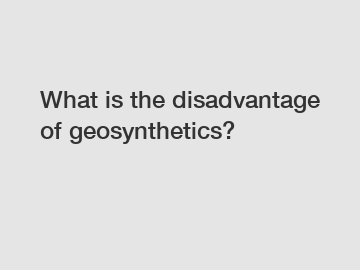Jan. 15, 2024
Construction & Real Estate
You will get efficient and thoughtful service from EcoGeoX.
Geosynthetics are engineered materials widely used in civil engineering and environmental applications due to their excellent physical properties and versatility. However, like any other material or technology, geosynthetics also come with some disadvantages that hinder their optimal performance and effectiveness in certain scenarios.
The main disadvantage of geosynthetics lies in their susceptibility to ultraviolet (UV) radiation degradation. As geosynthetics are often exposed to harsh outdoor conditions and sunlight, prolonged exposure to UV radiation can cause them to degrade over time. This deterioration process can weaken the material's strength, reduce its lifespan, and consequently compromise its performance in reinforcing or stabilizing soil structures. Furthermore, the breakdown of geosynthetics can lead to the release of microplastics, which pose potential environmental concerns.

The adverse effects of UV radiation on geosynthetics can be explained through a combination of chemical, physical, and mechanical processes. One of the main mechanisms behind UV degradation is photo-oxidation, wherein the energy from UV radiation causes bonds within the polymer structure to break, resulting in the formation of free radicals. These free radicals initiate a chain reaction that leads to further bond scission and the degradation of the material's mechanical properties. Additionally, exposure to UV radiation can cause the polymer chains to become brittle and prone to cracking, further accelerating deterioration.
The significance of understanding the disadvantages of geosynthetics lies in the need for proper design, installation, and maintenance practices to mitigate their negative effects. For instance, when geosynthetics are used in applications where prolonged exposure to UV radiation is inevitable, such as in landfill covers or exposed drainage systems, it becomes crucial to employ materials that are specifically formulated to resist UV degradation, such as UV-stabilized geosynthetics. Furthermore, implementing adequate protective measures like utilizing geotextile fabrics as UV barriers or placing additional layers of soil or vegetation over the geosynthetic can minimize UV exposure and prolong the material's lifespan.
The drawbacks associated with geosynthetics' susceptibility to UV degradation have raised concerns regarding the long-term performance and environmental impact of these materials. Efforts are underway to address these issues by developing advanced geosynthetics with enhanced UV resistance and exploring alternative sustainable materials for geotechnical applications. Additionally, the proper disposal and recycling of geosynthetics at the end of their lifespan can minimize the potential release of microplastics into the environment.
In conclusion, the disadvantage of geosynthetics lies in their susceptibility to UV degradation, which can weaken the material and reduce its effectiveness over time. Understanding the underlying mechanisms of this degradation process is crucial for implementing proper measures to mitigate its impact. By addressing this disadvantage through appropriate material selection and design practices, we can ensure the optimal performance and longevity of geosynthetic applications while minimizing their environmental footprint.
If you want to learn more, please visit our website.
For more information, please visit ldpe smooth geomembrane company.
If you are interested in sending in a Guest Blogger Submission,welcome to write for us!
All Comments ( 0 )